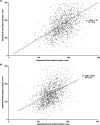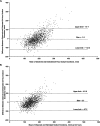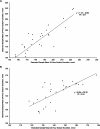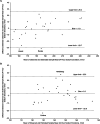Estimating 24-hour urinary sodium excretion from casual urinary sodium concentrations in Western populations: the INTERSALT study
- PMID: 23673246
- PMCID: PMC3664342
- DOI: 10.1093/aje/kwt066
Estimating 24-hour urinary sodium excretion from casual urinary sodium concentrations in Western populations: the INTERSALT study
Abstract
High intakes of dietary sodium are associated with elevated blood pressure levels and an increased risk of cardiovascular disease. National and international guidelines recommend reduced sodium intake in the general population, which necessitates population-wide surveillance. We assessed the utility of casual (spot) urine specimens in estimating 24-hour urinary sodium excretion as a marker of sodium intake in the International Cooperative Study on Salt, Other Factors, and Blood Pressure. There were 5,693 participants recruited in 1984-1987 at the ages of 20-59 years from 29 North American and European samples. Participants were randomly assigned to test or validation data sets. Equations derived from casual urinary sodium concentration and other variables in the test data were applied to the validation data set. Correlations between observed and estimated 24-hour sodium excretion were 0.50 for individual men and 0.51 for individual women; the values were 0.79 and 0.71, respectively, for population samples. Bias in mean values (observed minus estimated) was small; for men and women, the values were -1.6 mmol per 24 hours and 2.3 mmol per 24 hours, respectively, at the individual level and -1.8 mmol per 24 hours and 2.2 mmol per 24 hours, respectively, at the population level. Proportions of individuals with urinary 24-hour sodium excretion above the recommended levels were slightly overestimated by the models. Casual urine specimens may be a useful, low-burden, low-cost alternative to 24-hour urine collections for estimation of population sodium intakes; ongoing calibration with study-specific 24-hour urinary collections is recommended to increase validity.
Keywords: nutrition assessment; population surveillance; sodium intake.
Figures




Comment in
-
Invited commentary: Quantifying salt in urine--a complex solution.Am J Epidemiol. 2013 Jun 1;177(11):1193-5; discussion 1196-8. doi: 10.1093/aje/kwt064. Epub 2013 May 14. Am J Epidemiol. 2013. PMID: 23673248 Free PMC article.
References
-
- Conlin PR. Eat your fruits and vegetables but hold the salt. Circulation. 2007;116(14):1530–1531. - PubMed
-
- Sacks FM, Svetkey LP, Vollmer WM, et al. Effects on blood pressure of reduced dietary sodium and the Dietary Approaches to Stop Hypertension (DASH) diet. N Engl J Med. 2001;344(1):3–10. - PubMed
-
- Elliott P, Walker LL, Little MP, et al. Change in salt intake affects blood pressure of chimpanzees: Implications for human populations. Circulation. 2007;116(14):1563–1568. - PubMed
-
- Cutler JA. Randomized trials of sodium reduction: An overview. Am J Clin Nutr. 1997;65(suppl):643S–651S. - PubMed
-
- Midgley JP, Matthew AG, Greenwood CM, et al. Effect of reduced dietary sodium on blood pressure: a meta-analysis of randomized controlled trials. JAMA. 1996;275(20):1590–1597. - PubMed
Publication types
MeSH terms
Substances
Grants and funding
LinkOut - more resources
Full Text Sources
Other Literature Sources
Medical

